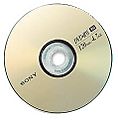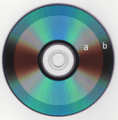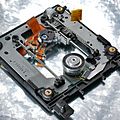DVD facts for kids
A DVD is a special type of disc that can hold a lot of information. The letters DVD stand for Digital Versatile Disc or Digital Video Disc. It's like a super-powered CD, able to store more than six times the data! A standard DVD can hold up to 4.7 GB of information.
People often use DVDs to watch movies because they offer much better quality than old VHS tapes. DVDs can also have cool extra features. These include interactive menus, deleted scenes, and even commentaries from the movie makers. Just like CDs, a special laser reads the information stored on a DVD.
DVDs come in different types, depending on how much data they can hold. This depends on whether they have one or two sides, and one or two layers of data on each side. A common 12 cm disc can have these storage amounts:
- DVD-5: This disc has one side and one layer. It can hold 4.7 GB of data.
- DVD-9: This disc has one side but two layers. It can hold 8.5 GB of data.
- DVD-10: This disc has two sides, with one layer on each side. It can hold 9.4 GB of data.
- DVD-14: This disc has two sides. One side has two layers, and the other has one layer. It can hold 13.3 GB of data.
- DVD-18: This disc has two sides, with two layers on both sides. It can hold 17.1 GB of data.
There are also smaller 8 cm DVDs. These can store about 1.5 GB of information.
You can often tell how much a DVD holds by looking at it. Discs with two layers of data usually look gold-colored. Single-layer discs are typically silver, just like a CD. Another way to check is to look at the center ring on the disc's underside. If you see two barcodes, it's a dual-layer disc. If there's only one barcode, it has a single layer.
How DVDs Store Data
Both CDs and DVDs are the same size. They have the same diameter and thickness. However, DVDs can store much more information. These discs are made from similar materials and use similar ways to be produced.
CDs and DVDs store information in a similar way. Both types of discs have tiny "pits" and "bumps" on their data track. The data track is like a long path that holds all the information. A laser then reads these pits and bumps to get the data.
A DVD disc has several layers, all made of plastic. Each layer is about 1.2 millimeters thick. To create the disc, a special process uses polycarbonate plastic. This process makes tiny bumps on the plastic. This type of plastic is used because it can handle very hot and very cold temperatures.
Once the layers are made, the bumps appear. Many bumps form one long, continuous spiral. This spiral holds all the information. After that, a special reflective layer is sprayed over the bumps.
The inner layers have aluminum behind them. The outer layers are covered with a semi-reflective gold. This design helps the laser focus through the outer layers to read the inner ones. Finally, a protective liquid called lacquer is added. The layers are pressed together and then treated with infrared light.
Tracks on a DVD Disc
Every track on a DVD disc spirals out from its center to the edge. The space between these tracks is very small, about 740 nanometers. Because the bumps are so tiny (about 320x400x120 nanometers), a very precise machine is needed to read them.
The side of the disc with aluminum has pits. But the side that the laser reads has bumps. Because these bumps are so small, a DVD track is incredibly long. A single data layer on a DVD is about 7.5 miles long! If a disc has two sides, the total track length would be about 30 miles.
Images for kids
-
PlayStation 2, the first video game console to run DVDs.
-
Scan of a DVD-R; the "a" portion has been recorded on while the "b" portion has not. It may be less obvious in CD-Rs and BD-Rs.
See also
 In Spanish: DVD para niños
In Spanish: DVD para niños











